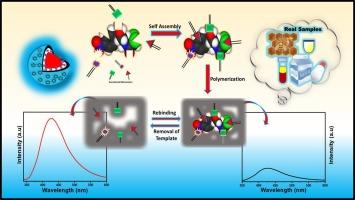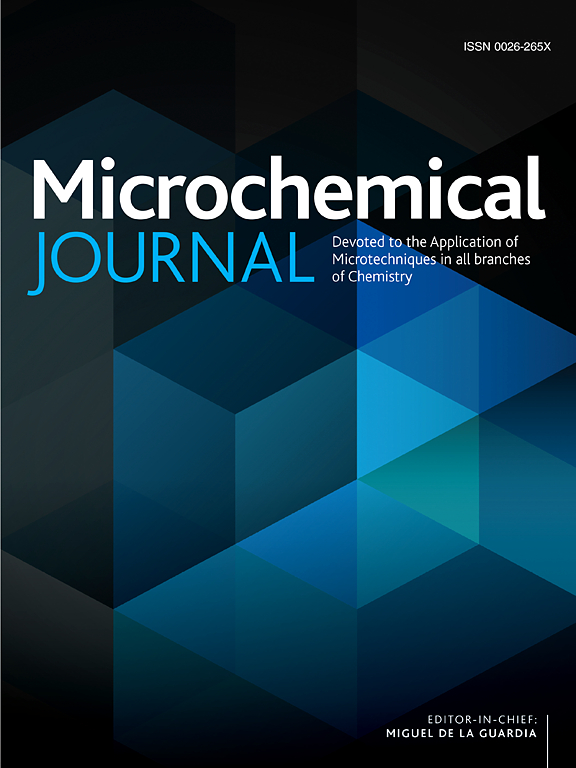A novel molecular imprinted polymer grafted on N, S Co-doped carbon quantum dots-based fluorescence sensor for chloramphenicol in food and clinical samples
IF 4.9
2区 化学
Q1 CHEMISTRY, ANALYTICAL
引用次数: 0
Abstract
Globally, antibiotic consumption surpasses thousands of tons on every year and even during this alarming state, the abundant traces of antibiotics have been found in the environment especially on water bodies and food producing creatures. The high accumulation of Chloramphenicol (CPL) may cause microbial resistance and lowering the general immunity. All these finding urges to develop a sensitive detection system for CPL. The present work describes the fabrication of Molecular Imprinted Polymer (MIP) grafted on Nitrogen and Sulfur doped Carbon Quantum Dots (N, S-CQDs) as a probe for the nanomolar level detection of CPL in food and clinical samples by using fluorescence technique. The developed N, S-CQDs based MIP sensor exhibits a bright fluorescence response and high recognition capability on CPL. The proposed sensor system has shown the detection limit of 7.65 nM and the linearity range was found between 0.24 μM and 26.1 μM. The real time consistency of the proposed sensor system has been verified by applying on clinical and food samples. Interestingly, we have received an excellent recovery varies from 97 % to 103 %. All these research outcomes further boost up the novel strategy to develop MIP based fluorescence probe for the detection of CPL.

接枝于 N、S 共掺杂碳量子点的新型分子印迹聚合物荧光传感器,用于检测食品和临床样本中的氯霉素
在全球范围内,抗生素的消耗量每年都超过数千吨,即使在这种令人担忧的状态下,环境中也发现了大量的抗生素痕迹,尤其是在水体和食品生产生物中。氯霉素(CPL)的大量积累可能会导致微生物产生抗药性,降低人体免疫力。所有这些发现都促使人们开发一种灵敏的 CPL 检测系统。本研究介绍了在掺氮和掺硫的碳量子点(N, S-CQDs)上接枝分子印迹聚合物(MIP)的制作过程,以此作为探针,利用荧光技术对食品和临床样本中的 CPL 进行纳摩尔级检测。所开发的基于 N, S-CQDs 的 MIP 传感器具有明亮的荧光响应和对 CPL 的高识别能力。拟议的传感器系统的检测限为 7.65 nM,线性范围为 0.24 μM 至 26.1 μM。拟议传感器系统的实时一致性已通过应用于临床和食品样品得到验证。有趣的是,我们获得了从 97 % 到 103 % 不等的出色回收率。所有这些研究成果进一步推动了基于 MIP 的荧光探针检测 CPL 的新策略的开发。
本文章由计算机程序翻译,如有差异,请以英文原文为准。
求助全文
约1分钟内获得全文
求助全文
来源期刊

Microchemical Journal
化学-分析化学
CiteScore
8.70
自引率
8.30%
发文量
1131
审稿时长
1.9 months
期刊介绍:
The Microchemical Journal is a peer reviewed journal devoted to all aspects and phases of analytical chemistry and chemical analysis. The Microchemical Journal publishes articles which are at the forefront of modern analytical chemistry and cover innovations in the techniques to the finest possible limits. This includes fundamental aspects, instrumentation, new developments, innovative and novel methods and applications including environmental and clinical field.
Traditional classical analytical methods such as spectrophotometry and titrimetry as well as established instrumentation methods such as flame and graphite furnace atomic absorption spectrometry, gas chromatography, and modified glassy or carbon electrode electrochemical methods will be considered, provided they show significant improvements and novelty compared to the established methods.
 求助内容:
求助内容: 应助结果提醒方式:
应助结果提醒方式:


